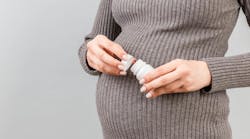Navigating pregnancy as a dental practitioner: Part 1
Listen to the article on our podcast!
Various physiological and pathological changes, including changes in oral health, often manifest during pregnancy. Hormones (gonadotropins) are largely responsible for sex drive, puberty, menstruation, pregnancy, and menopause, with progesterone and estrogen instrumental in sexuality and fertility.1
These two hormones cause enhanced vascularity, making pregnant women susceptible to periodontal diseases. Data from classic studies suggest that ovarian hormones alter the microenvironment of the oral bacteria, promoting bacterial growth and causing shifts in their populations.2 Periodontal status may deteriorate during gestation but generally improves postpartum.3
Increased incidence of caries and dental erosion have also been reported.4 Documented in 0.3%–2% of pregnant women, hyperemesis gravidarum is excessive vomiting, intractable nausea, and dry heaves.5 While initially the erosive lesions are not visible, the lesions caused by repetitive vomiting are often permanent and eventually become clinically observable.6 Table 1 provides tips for managing hyperemesis gravidarum.
Gestational diabetes (GDM), affecting 2%–7% of pregnant women, is high blood glucose levels during pregnancy and usually resolves postpartum.7 Meta-analysis suggests that periodontitis is associated with a statistically significant increased risk for GDM compared to women without periodontitis. Further, periodontal disease causes a systemic inflammatory state, making diabetes control more difficult.8
Laws governing pregnancy
For workers in large organizations and practices, three primary laws oversee pregnant workers: the Family Medical Leave Act (FMLA),9 the Pregnancy Discrimination Act (PDA),10 and the Pregnant Workers Fairness Act (PWFA).11 Table 2 describes each law. However, since many practices have fewer than 15 employees, they fail to offer the average dental worker protection under the law.
The PUMP for Nursing Mothers Act, or the PUMP Act, was enacted in December 2022.12 This law requires all employers to provide a reasonable break time for a mother to express milk. It acknowledges that the time necessary for pumping will vary per employee. Employers must provide a private place that is not a bathroom and is free from intrusions. Rights under this act are available for up to one year after childbirth and all employers must comply, regardless of the number of employees.
Occupational hazards in the dental office
General considerations: To reduce occupational hazards, notify your employer of pregnancy as early as possible for self-protection and to put safety measures in place. According to the CDC and the National Institute for Occupational Safety and Health (NIOSH), changes in metabolism during pregnancy increase how quickly chemicals are absorbed, especially metals.
Physical changes may result in ill-fitting personal protective equipment (PPE), and there can be changes in the immune system and lung capacity. Even ligaments can be altered, which can increase risk of injury due to workplace hazards.13 Early in pregnancy, the fetus may be more vulnerable to some chemical exposures during its rapid growth and development.
Nitrous oxide: NIOSH states that dental workers are exposed to nitrous oxide during its administration to patients.14 Exposure to nitrous oxide has been associated with reduced fertility, spontaneous abortion, and development of neurological, renal, and liver diseases.15
The ADA states that special consideration should be given to pregnant dental personnel whose duties involve direct exposure to nitrous oxide.16 They should be selective when using it and wear a monitoring badge (25 ppm is the recommended exposure limit for workers). There should be a written monitoring system and a maintenance plan. Use scavenging systems, and ensure that masks fit and are worn properly by patients. Perform system maintenance every three months, including appropriate ventilation, leak testing, and monitoring the air in the room.
Radiation: The ADA suggests that pregnant dental providers taking radiographs have a barrier strategy and wear a dosimetry badge to track radiation exposure. This may include self-shielding while standing two meters from the primary beam of the tube head.17
Exposure to infectious diseases and bloodborne pathogens: Proper use of PPE and following infection control policies are critical in protecting dental workers.18 The most concerning bloodborne pathogens in dentistry are hepatitis B and C and human immunodeficiency virus (HIV).19 The major risks of HIV infection in health-care settings are through percutaneous injuries (needlesticks) and mucous membrane/skin contact, rather than, as previously believed, through aerosols generated by rotary and surgical instruments and air water syringes.20 As mentioned, there can be changes in PPE fit during pregnancy,9 so the provider must ensure proper fit and adherence to OSHA guidelines for maximum protection.
Chemicals: Mercury may cause damage to the lungs, kidneys, nervous system, eyesight, and hearing.21 According to the CDC, women planning to become pregnant, who are currently pregnant, nursing women, and infants are at risk.22 The ADA suggests that developing neurological systems in fetuses cause more susceptibility to adverse effects, such as sensitivity to the neurotoxic effects of mercury vapor. However, they recommend that amalgam restorations be removed only if no longer intact as removal increases exposure to the mercury vapor.23
Pregnant dental workers should be aware of other chemicals that pose risks. Disinfectants, such as glutaraldehyde and sodium hypochlorite (bleach), are commonly used to sterilize instruments and surfaces. These chemicals can irritate eyes, skin, and respiratory system, and some studies suggest a possible link to birth defects.24,25 Additionally, certain solvents such as acetone and xylene, used for cleaning or removing dental materials, may be harmful if inhaled in large quantities and can cause developmental problems.26,27
Pregnant workers should be especially vigilant with disinfectant use, as research suggests a possible association with miscarriage and preterm birth.26 Consulting the Safety Data Sheets (SDSs) for these chemicals provides crucial information on their specific hazards, recommended safety precautions, and first aid measures.28 By understanding the information in the SDSs, pregnant dental workers can take steps to minimize their exposure and protect their health.
Protecting oral health and worker safety during pregnancy
Pregnancy brings significant physiological changes that can impact a dental worker's health and safety. We highlighted the increased risk of periodontal disease, cavities, and dental erosion during pregnancy. We also addressed potential hazards in the dental workplace, including exposure to nitrous oxide, radiation, infectious diseases, and chemicals such as mercury, and disinfectants.
To maintain good oral health, pregnant dental workers should prioritize regular dental checkups, practice meticulous oral hygiene, and be mindful of dietary changes. In the workplace, early communication with the employer is crucial. Pregnant workers can benefit from laws such as the Pregnant Workers Fairness Act (PWFA) and the PUMP Act, which ensure reasonable accommodations and breaks for nursing mothers.
By following safety protocols and minimizing exposure to hazardous materials, pregnant dental professionals can protect themselves and their developing babies while providing excellent patient care.
Editor's note: This article appeared in the Aug/Sept 2024 print edition of RDH magazine. Dental hygienists in North America are eligible for a complimentary print subscription. Sign up here.
References
1. Hyder T, Khan S, Moosa ZH. Dental care of the pregnant patient: an update of guidelines and recommendations. J Pak Med Assoc. 2023;73(10):2041-2046. doi:10.47391/JPMA.8400
2. Zachariasen RD. The effect of elevated ovarian hormones on periodontal health: oral contraceptives and pregnancy. Women Health. 1993:20(2):21-30. doi:10.1300/J012v20n02_02
3. González-Jaranay M, Téllez L, Roa-López A, Gómez-Moreno G, Moreu G. Periodontal status during pregnancy and postpartum. PLoS One. 2017;12(5):e0178234. doi:10.1371/journal.pone.0178234
4. Riggs E, Kilpatrick N, Slack‐Smith L, et al. Interventions with pregnant women, new mothers and other primary caregivers for preventing early childhood caries. Cochrane Database Syst Rev. 2019. doi:10.1002/14651858.CD012155
5. Fejzo MS, Trovik J, Grooten IJ, et al. Nausea and vomiting of pregnancy and hyperemesis gravidarum. Nat Rev Dis Primers. 2019;5(9):62. doi:10.1038/s41572-019-0110-3
6. Dean CR, Shemar M, Ostrowski GA, Painter RC. Management of severe pregnancy sickness and hyperemesis gravidarum. BMJ. 2018;(10):363. doi:10.1136/bmj.k5000
7. McIntyre HD, Catalano P, Zhang C, Desoye G, Mathiesen ER, Damm P. Gestational diabetes mellitus. Endocrinol Metab Clin North Am. 2019;5:1-9. doi:10.1016/j.ecl.2019.05.001
8. Abariga SA, Whitcomb BW. Periodontitis and gestational diabetes mellitus: a systematic review and meta-analysis of observational studies. BMC Pregnancy Childbirth. 2016;16(1):344.
9. U.S. Department of Labor. Family and Medical Leave Act. 2024. Accessed May 11, 2024. https://www.dol.gov/agencies/whd/fmla
10. American Dental Association. Highlights of the U.S. Equal Employment Opportunity Commission's Pregnancy Discrimination Act (PDA): Employers. Accessed May 11, 2024. https://www.ada.org/en/resources/practice/legal-and-regulatory/highlights-of-the-pregnancy-discrimination-act_employers
11. What you should know about the pregnant workers Fairness Act. U.S. Equal Employment Opportunity Commission. Accessed May 12, 2024. https://www.eeoc.gov/newsroom/eeoc-issues-proposed-rule-implement-pregnant-workers-fairness-act
12. Frequently asked questions—pumping breast milk at work. U.S. Department of Labor. Accessed May 11, 2024. https://www.dol.gov/agencies/whd/nursing-mothers/faq
13. Pregnancy and your job. Centers for Disease Control and Prevention. Accessed May 11, 2014. https://www.cdc.gov/niosh/topics/repro/pregnancyjob.html
14. Control of nitrous oxide in dental operatories. Centers for Disease Control and Prevention. January 1996. Accessed May 7, 2024. https://www.cdc.gov/niosh/docs/hazardcontrol/hc3.html
15. Controlling exposures to nitrous oxide during anesthetic administration. Centers for Disease Control and Prevention. National Institute for Occupational Safety and Health. https://www.cdc.gov/niosh/topics/nitrousoxide/default.html
16. Pregnancy. American Dental Association. Accessed May 7, 2024. https://engage.ada.org/catalog/pregnancy-and-oral-health-77943
17. Radiation safety for pregnant dental staff and patients. American Dental Association. Accessed May 7, 2024. https://www.ada.org/resources/practice/practice-management/radiation-safety-for-pregnant-dental-staff-and-patients#.YpKC3gaZ_FM.link
18. Occupational Health and Safety Administration. American Dental Association. Accessed May 11, 2024. https://www.ada.org/en/resources/ada-library/oral-health-topics/occupational-safety-and-health-administration
19. Bloodborne infectious diseases risk factors. Centers for Disease Control and Prevention. https://www.cdc.gov/niosh/healthcare/risk-factors/bloodborne-infectious-diseases.html
20. OSHA healthcare standards. Centers for Disease Control and Prevention. https://www.cdc.gov/niosh/learning/safetyculturehc/module-5/5.html
21. March of Dimes. https://www.marchofdimes.org/
22. Mercury. Centers for Disease Control and Prevention. https://www.cdc.gov/niosh/topics/mercury/default.html
23. Safety of dental amalgam for children under age 6 years: reaffirmation of 2009 guidance. J Dent Assoc. 2012;143(8):732-739. doi:10.1452/pdc.2012-00294
24. Lin S, Luo X, Liu Z, et al. Occupational exposures and adverse pregnancy outcomes: a meta-analysis and systematic review. Occup Environ Med. 2009;66(5):318-328. doi:10.1136/oem.2008.000223
25. Xylene program 2019. Accessed May 12, 2024. https://ors.od.nih.gov/sr/dohs/Documents/xylene-program.pdf
26. About chemical disinfectants and sterilants and reproductive health. Centers for Disease Control and Prevention. Accessed May 12, 2024. https://www.cdc.gov/niosh/reproductive-health/prevention/disinfectants.html
27. Acetone. Centers for Disease Control and Prevention. Accessed May 12, 2024. https://www.cdc.gov/niosh/npg/npgd0004.html
28. Hazard communication standard: safety data sheets. Occupational Safety and Health Administration. Accessed May 12, 2024. https://www.osha.gov/sites/default/files/publications/OSHA3514.pdf
Table 1: Tips to reduce the effects of hyperemesis gravidarum
|
Action |
Description |
|
Record vomiting |
Track the frequency, timing, and duration of vomiting episodes. This information helps your doctor assess the severity and plan treatment. |
|
Rinse mouth |
After vomiting, rinse your mouth with warm tap water or a weak salt solution (one-quarter teaspoon salt mixed with eight ounces of water). This helps neutralize stomach acid and prevent further irritation. |
|
Gentle brushing |
One hour after rinsing, gently brush teeth with a soft-bristled toothbrush and fluoride toothpaste. Frequent vomiting can erode tooth enamel, so brushing is crucial, but be gentle to avoid further irritation. |
|
Fluoride protection |
Consider applying fluoride varnish at your dentist's office or using prescribed home fluoride products. These measures help strengthen tooth enamel weakened by frequent vomiting. |
Table 2: Laws impacting the pregnant dental worker
|
Name of Act |
Required number of employees to be in effect |
Summary of the Act |
Restrictions |
Special considerations |
|
Family Medical Leave Act9 (FMLA) |
50+ |
Provides job protection for up to 12 weeks of leave in 12 months. |
Employees must exhaust accumulated paid leave benefits. |
May be used following birth, or after adoption or foster care. |
|
The Pregnancy Discrimination Act10 (PDA) |
15+ |
The employer cannot discriminate based on pregnancy, diminish years of experience, retirement, or seniority due to leave, and cannot single out for pregnancy-related conditions. |
If unable to perform job duties, the employee must be treated as any other temporarily disabled employee, such as a temporary job reassignment. |
The employee is allowed to work if they can perform their job duties. Health insurance coverage must be continued at the same level and amount as other employees. |
|
The Pregnant Workers Fairness Act (PWFA) |
15+ |
Requires employers to provide reasonable accommodations to their workers' known limitations relating to pregnancy unless accommodation will cause undue hardship. |
Employers must discuss and agree upon the accommodation for the employee. An employee cannot be made to take leave when reasonable accommodation can be provided. |
The law provides a “no tolerance policy” for retaliation against an individual for reporting/opposing discrimination, or for interfering with the employee's rights under the PWFA. |
About the Author

Alyshia Hanks, MHA, RDH, CDA
Alyshia Hanks, MHA, RDH, CDA, is an assistant professor who began her role in 2022 as the clinical coordinator for the dental hygiene program at the University of Southern Indiana. She teaches two didactic courses relating to clinical skills and direct patient care in addition to her time working with students and faculty in the clinic.

Lorinda L. Coan, MS, RDH
Associate Professor Lorinda L. Coan, MS, RDH, teaches dental hygiene at the University of Southern Indiana. She developed curricula and offers oral health-related education to health professional students in several of the other allied health baccalaureate and graduate programs at USI. Lorinda’s research focus includes multiple peer-reviewed publications on tobacco cessation, education, and interprofessional collaboration.


